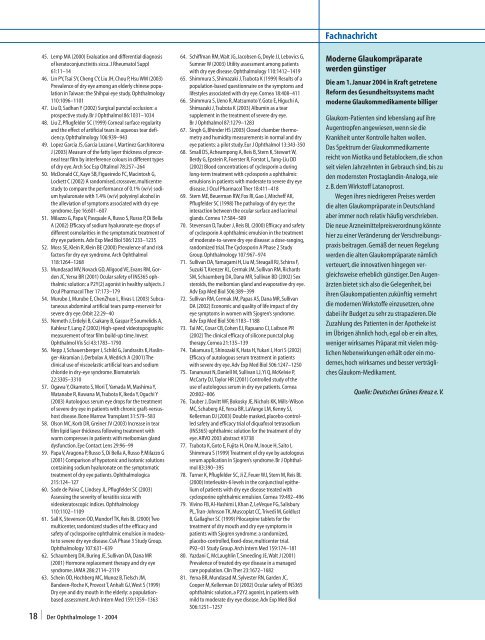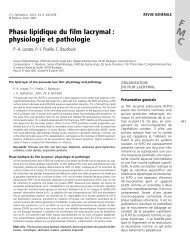Das trockene Auge: Ein Update über Epidemiologie, Diagnose
Das trockene Auge: Ein Update über Epidemiologie, Diagnose
Das trockene Auge: Ein Update über Epidemiologie, Diagnose
Erfolgreiche ePaper selbst erstellen
Machen Sie aus Ihren PDF Publikationen ein blätterbares Flipbook mit unserer einzigartigen Google optimierten e-Paper Software.
45. Lemp MA (2000) Evaluation and differential diagnosis<br />
of keratoconjunctivitis sicca. J Rheumatol Suppl<br />
61:11–14<br />
46. Lin PY,Tsai SY, Cheng CY, Liu JH, Chou P, Hsu WM (2003)<br />
Prevalence of dry eye among an elderly chinese population<br />
in Taiwan: the Shihpai eye study. Ophthalmology<br />
110:1096–1101<br />
47. Liu D, Sadhan Y (2002) Surgical punctal occlusion: a<br />
prospective study. Br J Ophthalmol 86:1031–1034<br />
48. Liu Z, Pflugfelder SC (1999) Corneal surface regularity<br />
and the effect of artificial tears in aqueous tear deficiency.<br />
Ophthalmology 106:939–943<br />
49. Lopez Garcia JS, Garcia Lozano I, Martinez Garchitorena<br />
J (2003) Measure of the fatty layer thickness of precorneal<br />
tear film by interference colours in different types<br />
of dry eye. Arch Soc Esp Oftalmol 78:257–264<br />
50. McDonald CC, Kaye SB, Figueiredo FC, Macintosh G,<br />
Lockett C (2002) A randomised, crossover, multicentre<br />
study to compare the performance of 0.1% (w/v) sodium<br />
hyaluronate with 1.4% (w/v) polyvinyl alcohol in<br />
the alleviation of symptoms associated with dry eye<br />
syndrome. Eye 16:601–607<br />
51. Milazzo G, Papa V, Pasquale A, Russo S, Russo P, Di Bella<br />
A (2002) Efficacy of sodium hyaluronate eye drops of<br />
different osmolarities in the symptomatic treatment of<br />
dry eye patients. Adv Exp Med Biol 506:1233–1235<br />
52. Moss SE, Klein R, Klein BE (2000) Prevalence of and risk<br />
factors for dry eye syndrome. Arch Ophthalmol<br />
118:1264–1268<br />
53. Mundasad MV, Novack GD, Allgood VE, Evans RM, Gorden<br />
JC,Yerxa BR (2001) Ocular safety of INS365 ophthalmic<br />
solution: a P2Y(2) agonist in healthy subjects. J<br />
Ocul Pharmacol Ther 17:173–179<br />
54. Murube J, Murube E, ChenZhuo L, Rivas L (2003) Subcutaneous<br />
abdominal artificial tears pump-reservoir for<br />
severe dry eye. Orbit 22:29–40<br />
55. Nemeth J, Erdelyi B, Csakany B, Gaspar P, Soumelidis A,<br />
Kahlesz F, Lang Z (2002) High-speed videotopographic<br />
measurement of tear film build-up time. Invest<br />
Ophthalmol Vis Sci 43:1783–1790<br />
56. Nepp J, Schauersberger J, Schild G, Jandrasits K, Haslinger-Akramian<br />
J, Derbolav A,Wedrich A (2001) The<br />
clinical use of viscoelastic artificial tears and sodium<br />
chloride in dry-eye syndrome. Biomaterials<br />
22:3305–3310<br />
57. Ogawa Y, Okamoto S, Mori T,Yamada M, Mashima Y,<br />
Watanabe R, Kuwana M,Tsubota K, Ikeda Y, Oguchi Y<br />
(2003) Autologous serum eye drops for the treatment<br />
of severe dry eye in patients with chronic graft-versushost<br />
disease. Bone Marrow Transplant 31:579–583<br />
58. Olson MC, Korb DR, Greiner JV (2003) Increase in tear<br />
film lipid layer thickness following treatment with<br />
warm compresses in patients with meibomian gland<br />
dysfunction. Eye Contact Lens 29:96–99<br />
59. Papa V, Aragona P, Russo S, Di Bella A, Russo P, Milazzo G<br />
(2001) Comparison of hypotonic and isotonic solutions<br />
containing sodium hyaluronate on the symptomatic<br />
treatment of dry eye patients. Ophthalmologica<br />
215:124–127<br />
60. Sade de Paiva C, Lindsey JL, Pflugfelder SC (2003)<br />
Assessing the severity of keratitis sicca with<br />
videokeratoscopic indices. Ophthalmology<br />
110:1102–1109<br />
61. Sall K, Stevenson OD, Mundorf TK, Reis BL (2000) Two<br />
multicenter, randomized studies of the efficacy and<br />
safety of cyclosporine ophthalmic emulsion in moderate<br />
to severe dry eye disease. CsA Phase 3 Study Group.<br />
Ophthalmology 107:631–639<br />
62. Schaumberg DA, Buring JE, Sullivan DA, Dana MR<br />
(2001) Hormone replacement therapy and dry eye<br />
syndrome. JAMA 286:2114–2119<br />
63. Schein OD, Hochberg MC, Munoz B,Tielsch JM,<br />
Bandeen-Roche K, Provost T, Anhalt GJ,West S (1999)<br />
Dry eye and dry mouth in the elderly: a populationbased<br />
assessment. Arch Intern Med 159:1359–1363<br />
| Der Ophthalmologe 1 · 2004<br />
18<br />
64. Schiffman RM,Walt JG, Jacobsen G, Doyle JJ, Lebovics G,<br />
Sumner W (2003) Utility assessment among patients<br />
with dry eye disease. Ophthalmology 110:1412–1419<br />
65. Shimmura S, Shimazaki J,Tsubota K (1999) Results of a<br />
population-based questionnaire on the symptoms and<br />
lifestyles associated with dry eye. Cornea 18:408–411<br />
66. Shimmura S, Ueno R, Matsumoto Y, Goto E, Higuchi A,<br />
Shimazaki J,Tsubota K (2003) Albumin as a tear<br />
supplement in the treatment of severe dry eye.<br />
Br J Ophthalmol 87:1279–1283<br />
67. Singh G, Bhinder HS (2003) Closed chamber thermometry<br />
and humidity measurements in normal and dry<br />
eye patients: a pilot study. Eur J Ophthalmol 13:343-350<br />
68. Small DS, Acheampong A, Reis B, Stern K, Stewart W,<br />
Berdy G, Epstein R, Foerster R, Forstot L,Tang-Liu DD<br />
(2002) Blood concentrations of cyclosporin a during<br />
long-term treatment with cyclosporin a ophthalmic<br />
emulsions in patients with moderate to severe dry eye<br />
disease. J Ocul Pharmacol Ther 18:411–418<br />
69. Stern ME, Beuerman RW, Fox RI, Gao J, Mircheff AK,<br />
Pflugfelder SC (1998) The pathology of dry eye: the<br />
interaction between the ocular surface and lacrimal<br />
glands. Cornea 17:584–589<br />
70. Stevenson D,Tauber J, Reis BL (2000) Efficacy and safety<br />
of cyclosporin A ophthalmic emulsion in the treatment<br />
of moderate-to-severe dry eye disease: a dose-ranging,<br />
randomized trial.The Cyclosporin A Phase 2 Study<br />
Group. Ophthalmology 107:967–974<br />
71. Sullivan DA,Yamagami H, Liu M, Steagall RJ, Schirra F,<br />
Suzuki T, Krenzer KL, Cermak JM, Sullivan RM, Richards<br />
SM, Schaumberg DA, Dana MR, Sullivan BD (2002) Sex<br />
steroids, the meibomian gland and evaporative dry eye.<br />
Adv Exp Med Biol 506:389–399<br />
72. Sullivan RM, Cermak JM, Papas AS, Dana MR, Sullivan<br />
DA (2002) Economic and quality of life impact of dry<br />
eye symptoms in women with Sjogren’s syndrome.<br />
Adv Exp Med Biol 506:1183–1188<br />
73. Tai MC, Cosar CB, Cohen EJ, Rapuano CJ, Laibson PR<br />
(2002) The clinical efficacy of silicone punctal plug<br />
therapy. Cornea 21:135–139<br />
74. Takamura E, Shinozaki K, Hata H,Yukari J, Hori S (2002)<br />
Efficacy of autologous serum treatment in patients<br />
with severe dry eye. Adv Exp Med Biol 506:1247–1250<br />
75. Tananuvat N, Daniell M, Sullivan LJ,Yi Q, McKelvie P,<br />
McCarty DJ,Taylor HR (2001) Controlled study of the<br />
use of autologous serum in dry eye patients. Cornea<br />
20:802–806<br />
76. Tauber J, Davitt WF, Bokosky JE, Nichols KK, Mills-Wilson<br />
MC, Schaberg AE,Yerxa BR, LaVange LM, Kenny SJ,<br />
Kellerman DJ (2003) Double masked, placebo-controlled<br />
safety and efficacy trial of diquafosol tetrasodium<br />
(INS365) ophthalmic solution for the treatment of dry<br />
eye. ARVO 2003 abstract #3738<br />
77. Tsubota K, Goto E, Fujita H, Ono M, Inoue H, Saito I,<br />
Shimmura S (1999) Treatment of dry eye by autologous<br />
serum application in Sjogren’s syndrome. Br J Ophthalmol<br />
83:390–395<br />
78. Turner K, Pflugfelder SC, Ji Z, Feuer WJ, Stern M, Reis BL<br />
(2000) Interleukin-6 levels in the conjunctival epithelium<br />
of patients with dry eye disease treated with<br />
cyclosporine ophthalmic emulsion. Cornea 19:492–496<br />
79. Vivino FB, Al-Hashimi I, Khan Z, LeVeque FG, Salisbury<br />
PL,Tran-Johnson TK, Muscoplat CC,Trivedi M, Goldlust<br />
B, Gallagher SC (1999) Pilocarpine tablets for the<br />
treatment of dry mouth and dry eye symptoms in<br />
patients with Sjogren syndrome: a randomized,<br />
placebo-controlled, fixed-dose, multicenter trial.<br />
P92–01 Study Group. Arch Intern Med 159:174–181<br />
80. Yazdani C, McLaughlin T, Smeeding JE,Walt J (2001)<br />
Prevalence of treated dry eye disease in a managed<br />
care population. Clin Ther 23:1672–1682<br />
81. Yerxa BR, Mundasad M, Sylvester RN, Garden JC,<br />
Cooper M, Kellerman DJ (2002) Ocular safety of INS365<br />
ophthalmic solution, a P2Y2 agonist, in patients with<br />
mild to moderate dry eye disease. Adv Exp Med Biol<br />
506:1251–1257<br />
Fachnachricht<br />
Moderne Glaukompräparate<br />
werden günstiger<br />
Die am 1. Januar 2004 in Kraft getretene<br />
Reform des Gesundheitssystems macht<br />
moderne Glaukommedikamente billiger<br />
Glaukom-Patienten sind lebenslang auf ihre<br />
<strong>Auge</strong>ntropfen angewiesen, wenn sie die<br />
Krankheit unter Kontrolle halten wollen.<br />
<strong>Das</strong> Spektrum der Glaukommedikamente<br />
reicht von Miotika und Betablockern, die schon<br />
seit vielen Jahrzehnten in Gebrauch sind, bis zu<br />
den modernsten Prostaglandin-Analoga, wie<br />
z. B. dem Wirkstoff Latanoprost.<br />
Wegen ihres niedrigeren Preises werden<br />
die alten Glaukompräparate in Deutschland<br />
aber immer noch relativ häufig verschrieben.<br />
Die neue Arzneimittelpreisverordnung könnte<br />
hier zu einer Veränderung der Verschreibungspraxis<br />
beitragen. Gemäß der neuen Regelung<br />
werden die alten Glaukompräparate nämlich<br />
verteuert, die innovativen hingegen vergleichsweise<br />
erheblich günstiger. Den <strong>Auge</strong>närzten<br />
bietet sich also die Gelegenheit, bei<br />
ihren Glaukompatienten zukünftig vermehrt<br />
die modernen Wirkstoffe einzusetzen, ohne<br />
dabei ihr Budget zu sehr zu strapazieren. Die<br />
Zuzahlung des Patienten in der Apotheke ist<br />
im Übrigen ähnlich hoch, egal ob er ein altes,<br />
weniger wirksames Präparat mit vielen möglichen<br />
Nebenwirkungen erhält oder ein modernes,<br />
hoch wirksames und besser verträgliches<br />
Glaukom-Medikament.<br />
Quelle: Deutsches Grünes Kreuz e. V.



